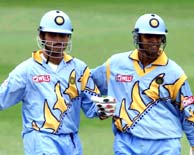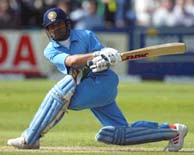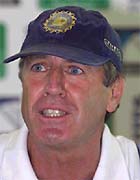Decentralization of the 'National Grip'
Bharath Ram
There IS euphoria surrounding India's victory at Lord's. I am not saying this because this is an obvious fact, but am saying it in a re-assuring sense, in case the focus of attention and news items lead one to believe otherwise. The news still does not completely revolve around the team or Mohammed Kaif. The news, hype and fixation are still focused on Sachin Tendulkar.
It must be staggering to many long-time cricket viewers, not to mention the man himself, that after witnessing a watershed moment in Indian ODI history, people are gleefully taking potshots at him and how he "choked" when it mattered, instead of focusing on the team victory. I think people are losing perspective here. One has to be aware of history to comprehend the value of this victory and the work involved in bringing about this victory. One does not mock at Sachin now, given his contribution over time to make victories such as this possible; one should feel happy that there are talented people to grab the baton from him and run further and faster.
 1996, Wankhede stadium, World Cup league match - India Vs Australia: It was Sunil Gavaskar in the commentary box, Sachin Tendulkar, at the crease, chasing a. then, mammoth score of 275. As the camera zooms in on Sachin's batting grip, Sunny said: "For long his grip has been considered the national grip, the fate of the whole country rests on this grip." The "national grip" did comprehensively defeat McGrath and Warne, but got stumped to a wide ball from Mark Waugh on 92 and India lost.
1996, Wankhede stadium, World Cup league match - India Vs Australia: It was Sunil Gavaskar in the commentary box, Sachin Tendulkar, at the crease, chasing a. then, mammoth score of 275. As the camera zooms in on Sachin's batting grip, Sunny said: "For long his grip has been considered the national grip, the fate of the whole country rests on this grip." The "national grip" did comprehensively defeat McGrath and Warne, but got stumped to a wide ball from Mark Waugh on 92 and India lost.
But Sunny was not far from the truth.
The "Desert storm" innings in 1998 and Sachin's otherwise amazing run in 1998, after being relegated from the captain's seat, is now part of folklore or, more precisely, history. I suspect, it may go down as Sachin's best run of form, in his entire career, although I would be happy to be proven wrong. All these years Sachin would be at pains to explain to the western media that India was not a one-man team. He had everything, but facts, to prove his point.
1998, when India was winning almost any cup that was in the offing, Sachin was toasted as the country's one-man-army. India was labeled as a team consisting of Sachin Tendulkar and 10 other blurry individuals, who were, background artists, at best. The Sri Lanka Independence Cup in 1998 was the zenith. Sachin and Saurav put together an amazing opening partnership to settle the match in India's favour. No one could have possibly imagined, that for four years from that point, India would not win any championship contested by more than two teams. Three was a crowd for the Indian cricket team. Too bad cricket and marriage aren't the same.
Come the Natwest trophy, and India have finally shattered the tournament finals jinx with a resounding victory over England.
I have made an attempt to analyze the metamorphosis that happened in the past four years, which saw India being labeled with many descriptions -- such as potential world-beaters, one of the worst ODI and Test teams, match-fixer's syndicate, one-man team -- to the latest, but not the newest description; potential world beaters.
As an admirer of Sachin's artistry as a batsman, I was happy that he was scoring runs, but the fact remained that this is a team game and the team needs to click as a unit to give itself any chance of becoming what the Aussies are today. The big change definitely involved the "decentralization" of the "national grip". The core nucleus of the team needed to include more people than Sachin Tendulkar.
Now, in the era of post-Laxman's 281 and post-Natwest trophy, the "decentralisation" seems to be almost complete. Sunny Gavaskar, to complete the proverbial circle, has said something about, Sachin letting down the team in finals. The story is not about how Sachin was dethroned, but how this Robinhood got his merry men.
 The advent of Ganguly and Dravid in 1996, did lessen the burden on Sachin's shoulder but the transition was not immediate and sometimes appeared, even, ephemeral. Ganguly figured in the ODIs in Sri Lanka's Singer Cup, 1996, under Sachin's captaincy. The wily Aussies, then, somehow found out that Ganguly had a leg-stump-line weakness, which bowlers exploited to their hearts content until Alan Donald probed him just outside the off-stump to find a new weakness.
The advent of Ganguly and Dravid in 1996, did lessen the burden on Sachin's shoulder but the transition was not immediate and sometimes appeared, even, ephemeral. Ganguly figured in the ODIs in Sri Lanka's Singer Cup, 1996, under Sachin's captaincy. The wily Aussies, then, somehow found out that Ganguly had a leg-stump-line weakness, which bowlers exploited to their hearts content until Alan Donald probed him just outside the off-stump to find a new weakness.
In the Titan Cup that followed, Sachin experimented with Ganguly as his opening partner. The ploy seemed to work well in the Hyderabad game against the South Africans, when the duo put on 126, the first of their many century partnerships. But, there was a catch; Ganguly was a four or nothing fellow; he couldn't rotate the strike and his scoring rate wasn't as impressive, as it is today.
Dravid on the other hand, was classy, stylish and all that, but he had a minor flaw: he couldn't score fast enough. Dravid's second year in international cricket was so horrible that he was dropped from the ODI team. But, at least, India did have a 'Fab Four' thing going on, with the mercurial Azhar completing the quartet. Dravid and Ganguly did provide some glorious moments in ODIs. Like, for example, Dravid's century against Pakistan in the Indian Independence Cup and Ganguly's, then described by Sachin as the "secret weapon", exploits in Canada. But it was not until the 1999 World Cup, did they become a big force in the ODI world. The game against Sri Lanka proved to the world that they could win games on their own.
The most significant strides in the "decentralization" process did not begin until John Wright and Ganguly were at the helm of affairs. A long and sincere search for talent began under the Wright and Ganguly combine that eventually zeroed in on Sehwag, Yuvraj and later Mohd. Kaif.
Meanwhile, when the search for talent was happening, India did begin to play well and performed, all right, without being too Sachin dependent.
 However, it started stumbling in the finals of championships. Getting as far as the finals is a good thing, but loosing always didn't look good. A lot of attention was given to Sachin's failure in the finals, which is surprising, since a huge section of the people had completely forgotten that the Big 2 --Ganguly and Dravid -- of the Big 3, didn't crown themselves with glory, either. They are as much to blame for all the finals, including the Natwest finals, for throwing away their wickets when they were needed most, as much as Sachin.
However, it started stumbling in the finals of championships. Getting as far as the finals is a good thing, but loosing always didn't look good. A lot of attention was given to Sachin's failure in the finals, which is surprising, since a huge section of the people had completely forgotten that the Big 2 --Ganguly and Dravid -- of the Big 3, didn't crown themselves with glory, either. They are as much to blame for all the finals, including the Natwest finals, for throwing away their wickets when they were needed most, as much as Sachin.
The wild heave against Alex Tudor, when Ganguly was 60 and well settled, would have received worldwide condemnation, if it was Sachin, instead of Ganguly, playing that shot. What Dravid was trying to do playing that uppish on side shot is a secret best kept to himself.
England's winter trip to India saw a huge change in the Indian batting order, Sehwag got to open with Sachin, with Ganguly coming in at four. The opening combination was a remarkable success, even though England managed to crawl their way back into the series. The final game in Mumbai was lost due to the collective stupidity of the team, but, as is usual, Sachin's "choking" was again made a major issue.
That is where I began to wonder if the analysis of why India was loosing was being done right. When Sachin and Sourav fail, it is time for the back-up act to do their thing. When the back-up men in Sehwag, Mongia, and to an extent Dravid. failed to give support, the reason for failure needs to have something more, than Sachin throwing away his wicket, to it.
It now appears that the head inside the thinking cap was doing its job. During the Zimbabwe series, where, in the absence of Sachin and Sehwag, Ganguly was once again in the openers' role with new face Dinesh Mongia, evidence of planning, came to light, when Ganguly then announced that major changes were being planned for the ODI team.
In the Windies ODI series, the strategy was bared. Dravid would keep wickets, thereby making room for another specialist batsman and Sachin would bat at number 4. It was a masterstroke and disaster recipe all rolled into one. It had all the randomness of an atom in a heated state. Since this is the most significant change made in the whole "decentralisation" thingie, this had the potential to make most impact, positive or otherwise.
Sachin, we all know, does not like to bat down the order. No matter what he says for public consumption, we all know how he disliked it when the selectors made him bat at #4 in South Africa. Though that was more a case of the team choking, when Sachin got out, than anything else. I wouldn't fault Sachin if he secretly disapproved of this move. He was by no means at # 4 because he lacked the merit to open. He was the man of the series, in the last series he opened and he could still walk into most ODI teams as an opener.
It was the team management's decision, and to give credit to the great man, he complied. To those who think that a player should dance to the tune of the team management, imagine yourself, a senior executive, being relegated to a role you don't like in your work place. Just because it was some manager's bright idea! Team spirit and all that sounds fine but every player should be convinced of the reason behind the change, that is also very much part of the team spirit.
 The team management, especially John Wright, was being very clever about announcing this change. Wright softened the blow, by saying Sachin would still open, when India batted first. That was never going to happen and he knew it even while he announced otherwise. Dravid, as keeper, will be proven right and wrong on an alternate basis. My take is, if we get a Mohd. Kaif every time Dravid dons the glove, who cares?!
The team management, especially John Wright, was being very clever about announcing this change. Wright softened the blow, by saying Sachin would still open, when India batted first. That was never going to happen and he knew it even while he announced otherwise. Dravid, as keeper, will be proven right and wrong on an alternate basis. My take is, if we get a Mohd. Kaif every time Dravid dons the glove, who cares?!
All these carefully planned and some unplanned changes have resulted in the current Indian line-up, which we see today, and, hopefully, we shall be seeing this till the World Cup. I have deliberately avoided mentioning any bowlers because I frankly think they are not going to win matches. We will have to get used to chasing 325-ish totals, Period.
If the team management wants to do themselves any favours, they should drop Kumble from the scheme of things. In any case ODIs are batsmen centric games and I think we have got our batting order right. The National Grip is tight and has more strings to its bow than it ever had. The world better pay attention. If Sachin don't hit you, six others will !
Editor's note: Rediff believes that like its own editorial staffers, readers too have points of view on the many issues relating to cricket as it is played.
Therefore, Rediff provides in its editorial section space for readers to write in, with their views. The views expressed by the readers are carried as written, in order to preserve the original voice.
However, it needs mentioning that guest columns are opinion pieces, and reflect only the feelings of the individual concerned -- the fact that they are published on Rediff's cricket site does not amount to an endorsement by the editorial staff of the opinions expressed in these columns.
Mail Bharath Ram